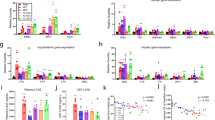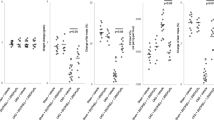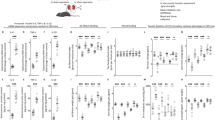Abstract
Clinical wasting is an important risk factor for mortality in uremic patients and is reported to have a prevalence of 30–60%. 'Malnutrition' is often inappropriately used to describe a group of nutritional abnormalities in uremic patients, which are characterized by anorexia, increased basal metabolic rate, loss of lean body mass, and declining levels of serum proteins. This syndrome—more accurately described as 'cachexia'—manifests as growth failure in children with uremia. Acidosis and inflammation are important causes of uremic cachexia but the underlying molecular mechanism is not well understood. Concentrations of circulating cytokines, such as leptin, tumor necrosis factor-α, interleukin-1, and interleukin-6, are elevated in patients with end-stage renal disease and correlate with the degree of cachexia in these individuals. Other energy-modulating hormones such as ghrelin, and adipokines such as adiponectin and resistin, are also perturbed in uremia and could contribute to nutritional abnormalities. We recently showed that elevated levels of circulating cytokines might be an important contributor to uremia-associated cachexia via signaling through the central melanocortin system. Small-molecule melanocortin antagonists, which are biologically active when administered orally or intraperitoneally, are now available and have been used successfully to ameliorate experimental cachexia. These findings could form the basis of a novel therapeutic strategy for uremic cachexia.
Key Points
-
The prevalence of clinical wasting—an important risk factor for mortality—in end-stage renal disease is 30–60%
-
Cachexia in uremic patients manifests as anorexia, increased basal metabolic rate, loss of lean body mass, and declining levels of serum proteins
-
The mechanisms through which acidosis and inflammation cause uremic cachexia are not well understood
-
New data indicate that circulating cytokines—levels of which are increased in end-stage renal disease—and other energy-modulating hormones might act on the hypothalamic melanocortin system in the pathogenesis of uremic cachexia
-
Antagonists of melanocortin receptors can ameliorate experimental cachexia
This is a preview of subscription content, access via your institution
Access options
Subscribe to this journal
Receive 12 print issues and online access
$209.00 per year
only $17.42 per issue
Buy this article
- Purchase on Springer Link
- Instant access to full article PDF
Prices may be subject to local taxes which are calculated during checkout

Similar content being viewed by others
References
Gruppen MP et al. (2003) Cardiac disease in young adult patients with end-stage renal disease since childhood: a Dutch cohort study. Kidney Int 63: 1058–1065
Sarnak MJ and Levey AS (2000) Cardiovascular disease and chronic renal disease: a new paradigm. Am J Kidney Dis 35: S117–S131
Cianciaruso B et al. (1995) Cross-sectional comparison of malnutrition in continuous ambulatory peritoneal dialysis and hemodialysis patients. Am J Kidney Dis 26: 475–486
Tisdale MJ (1997) Biology of cachexia. J Natl Cancer Inst 89: 1763–1773
Kotler DP et al. (1989) Magnitude of body-cell-mass depletion and the timing of death from wasting in AIDS. Am J Clin Nutr 50: 444–447
Sherry BA et al. (1989) Anticachectin/tumor necrosis factor-alpha antibodies attenuate development of cachexia in tumor models. FASEB J 3: 1956–1962
Fong Y et al. (1989) Cachectin/TNF or IL-1 alpha induces cachexia with redistribution of body proteins. Am J Physiol 256: R659–665
Plata-Salaman CR et al. (1996) Anorexia induced by chronic central administration of cytokines at estimated pathophysiological concentrations. Physiol Behav 60: 867–875
Scribner BH et al. (1960) The treatment of chronic uremia by means of intermittent hemodialysis: a preliminary report. Trans Am Soc Artif Intern Organs 6: 114–122
Anderstam B et al. (1996) Middle-sized molecule fractions isolated from uremic ultrafiltrate and normal urine inhibit ingestive behavior in the rat. J Am Soc Nephrol 7: 2453–2460
Mamoun AH et al. (1999) Evidence of splanchnic-brain signaling in inhibition of ingestive behavior by middle molecules. J Am Soc Nephrol 10: 309–314
Pecoits-Filho R et al. (2005) Chronic kidney disease and inflammation in pediatric patients: from bench to playground. Pediatr Nephrol 20: 714–720
Kaizu Y et al. (2003) Association between inflammatory mediators and muscle mass in long-term hemodialysis patients. Am J Kidney Dis 42: 295–302
Bologa RM et al. (1998) Interleukin-6 predicts hypoalbuminemia, hypocholesterolemia, and mortality in hemodialysis patients. Am J Kidney Dis 32: 107–114
Goodman MN (1994) Interleukin-6 induces skeletal muscle protein breakdown in rats. Proc Soc Exp Biol Med 205: 182–185
Tsujinaka T et al. (1996) Interleukin 6 receptor antibody inhibits muscle atrophy and modulates proteolytic systems in interleukin 6 transgenic mice. J Clin Invest 97: 244–249
Aguilera A et al. (1998) Anorexigen (TNF alpha, cholecystokinin) and orexigen (neuropeptide Y) in peritoneal dialysis patients. Their relationship with nutritional parameters. Nephrol Dial Transplant 13: 1476–1483
Guttridge DC et al. (2000) NF-κB induced loss of MyoD messenger RNA: Possible role in muscle decay and cachexia. Science 289: 2363–2365
Plata-Salaman CR (1998) Cytokines and anorexia: a brief overview. Semin Oncol 25: 4–11
Schwartz MW and Morton GJ (2002) Obesity: Keeping hunger at bay. Nature 418: 595–597
Ahima RS and Staels B (2000) Leptin. Ann Rev Physiol 62: 413–437
Halaas J et al. (1995) Weight-reducing effects of plasma protein encoded by the obese gene. Science 269: 543–549
Sharma K et al. (1997) Plasma leptin is partly cleared by the kidney and is elevated in hemodialysis patients. Kidney Int 51: 1980–1985
Stenvinkel P et al. (2000) Increases in serum leptin during peritoneal dialysis are associated with inflammation and a decrease in lean body mass. J Am Soc Nephrol 11: 1303–1309
Daschner M et al. (1998) Inappropriate elevation of serum leptin in children with chronic renal failure. European Study Group for Nutritional Treatment of Chronic Renal Failure in Chilhood. J Am Soc Nephrol 9: 1074–1079
Wolf G et al. (2002) Leptin and renal disease. Am J Kidney Dis 39: 1–11
Heimburger O and Stenvinkel P (2005) Adipokines in chronic kidney disease—fat tissue gives nephrologists a message. Perit Dial Int 25: 340–342
Qi Y et al. (2004) Adiponectin acts in the brain to decrease body weight. Nature Med 10: 524–529
Axelsson J et al. (2006) Elevated resistin levels in chronic kidney disease are associated with decreased glomerular filtration rate and inflammation, but not with insulin resistance. Kidney Int 69: 596–604
Gomez-Ambrosi J et al. (2002) Weight loss in tumour-bearing mice is not associated with changes in resistin gene expression in white adipose tissue. Horm Metab Res 34: 674–677
Palanivel R and Sweeney G (2005) Regulation of fatty acid uptake and metabolism in L6 skeletal muscle cells by resistin. FEBS Lett 579: 5049–5054
Yoshimoto A et al. (2002) Plasma ghrelin and desacyl ghrelin concentrations in renal failure. J Am Soc Nephrol 13: 2748–2752
Rodriguez Ayala E et al. (2004) Associations between plasma ghrelin levels and body composition in end-stage renal disease: a longitudinal study. Nephrol Dial Transplant 19: 421–426
Wynne K et al. (2005) Subcutaneous ghrelin enhances acute food intake in malnourished patients who receive maintenance peritoneal dialysis: a randomized, placebo-controlled trial. J Am Soc Nephrol 6: 2111–2118
Cheung W et al. (2005) Role of leptin and melanocortin signaling in uremia-associated cachexia. J Clin Invest 115: 1659–1665
Madiehe AM et al. (2003) Hyperleptinemia and reduced TNF-alpha secretion cause resistance of db/db mice to endotoxin. Am J Physiol Regul Integr Comp Physiol 284: R763–R770
Marks DL et al. (2001) Role of central melanocortin system in cachexia. Cancer Res 61: 1432–1438
Mitch WE and Goldberg AL (1996) Mechanisms of muscle wasting: the role of the ubiquitin-proteasome pathway. N Engl J Med 335: 1897–1905
Mitch WE et al. (1994) Metabolic acidosis stimulates muscle protein degradation by activating the adenosine triphosphate-dependent pathway involving ubiquitin and proteasomes. J Clin Invest 93: 2127–2133
Isozaki U et al. (1996) Protein degradation and increased mRNAs encoding proteins of the ubiquitin-proteasome proteolytic pathway in BC3H1 myocytes require an interaction between glucocorticoids and acidification. Proc Natl Acad Sci USA 93: 1967–1971
Price SR et al. (1996) Muscle wasting in insulinopenic rats results from activation of the ATP-dependent, ubiquitin-proteasome proteolytic pathway by a mechanism including gene transcription. J Clin Invest 98: 1703–1708
Motil KJ et al. (1981) Whole-body leucine and lysine metabolism: response to dietary protein intake in young men. Am J Physiol 240: E712–E721
Tom K et al. (1995) Long-term adaptive responses to dietary protein restriction in chronic renal failure. Am J Physiol 268: E668–E677
Maroni BJ et al. (1997) Mechanisms permitting nephrotic patients to achieve nitrogen equilibrium with a protein-restricted diet. J Clin Invest 99: 2479–2487
Mitch WE (2002) Requirements for protein, calories, and fat in the predialysis patient. In Handbook of Nutrition and the Kidney, 144–165 (Eds Mitch WE and Klahr S) Philadelphia: Lippincott, Williams and Wilkins
Simons JP et al. (1999) Weight loss and low body cell mass in males with lung cancer: relationship with systemic inflammation, acute-phase response, resting energy expenditure, and catabolic and anabolic hormones. Clin Sci 97: 215–223
Munro R and Capell H (1997) Prevalence of low body mass in rheumatoid arthritis: associations with the acute phase response. Ann Rheum Dis 56: 326–329
Stenvinkel P et al. (2000) Are there two types of malnutrition in chronic renal failure? Evidence for relationships between malnutrition, inflammation and atherosclerosis (MIA syndrome). Nephrol Dial Transplant 15: 953–960
Pupim LB et al. (2002) Intradialytic parenteral nutrition improves protein and energy homeostasis in chronic hemodialysis patients. J Clin Invest 110: 483–492
Betts PR and McGrath G (1974) Growth patterns and dietary intake of children with chronic renal insufficiency. Br Med J 2: 189–193
Simmons JM et al. (1971) Relation of calorie deficiency to growth failure in children on hemodialysis and the growth response to calorie supplementation. N Engl J Med 285: 653–656
Arnold WC et al. (1983) Effect of calorie supplementation on growth in children with uremia. Kidney Int 24: 205–209
Walker S et al. (2003) Catch-up growth with normal parathyroid hormone levels in chronic renal failure. Pediatr Nephrol 18: 1236–1241
Jones RW et al. (1982) The effects of chronic renal failure in infancy on growth, nutritional status and body compositioin. Pediatr Res 16: 784–791
Markison S et al. (2005) The regulation of feeding and metabolic rate and the prevention of murine cancer cachexia with a small-molecule melanocortin-4 receptor antagonist. Endocrinology 146: 2766–2773
Horvath TL (2005) The hardship of obesity: a soft-wired hypothalamus. Nature Neurosci 8: 561–565
Cone RD (2005) Anatomy and regulation of the central melanocortin system. Nature Neurosci 8: 571–578
Acknowledgements
This work was supported by grants, R01 DK 50780 and K24 DK 59475 to RHM and K08 DK 62207 to DLM, from the NIH.
Author information
Authors and Affiliations
Corresponding author
Ethics declarations
Competing interests
The authors declare no competing financial interests.
Rights and permissions
About this article
Cite this article
Mak, R., Cheung, W., Cone, R. et al. Mechanisms of Disease: cytokine and adipokine signaling in uremic cachexia. Nat Rev Nephrol 2, 527–534 (2006). https://doi.org/10.1038/ncpneph0273
Received:
Accepted:
Issue Date:
DOI: https://doi.org/10.1038/ncpneph0273
This article is cited by
-
Highlighting the idea of exerkines in the management of cancer patients with cachexia: novel insights and a critical review
BMC Cancer (2023)
-
Lipocalin 2 mediates appetite suppression during pancreatic cancer cachexia
Nature Communications (2021)
-
Interleukin-1β signaling in fenestrated capillaries is sufficient to trigger sickness responses in mice
Journal of Neuroinflammation (2017)



